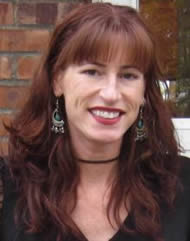 Karen Dobkins
 Leslie Carver
For most of us, our senses help us experience the world in myriad ways, whether it's a simple pleasure such as eating a strawberry or something more complex such as spending a day at the beach. Vision, smell, taste and touch integrate to help shape our response to the world around us. For children with autism, however, sensory integration problems are often common and can affect them profoundly. An ordinary sound can cause pain. Something soft can be construed as rough and unpleasant. According to the Autism Society of America, many professionals feel that some of the typical behaviors of autism are actually a result of sensory integration difficulties.
UC San Diego psychology professor Karen Dobkins, Ph.D. '92 and psychology associate professor Leslie Carver are exploring whether sensory processing abnormalities may have an impact on the development of autism. They are using a new approach to test this hypothesis and study the developmental disorder which affects an estimated 1.5 million individuals in the U.S.
The approach consists of tracking development in infants who were born into a family that already has one child with autism. As there is a strong genetic component to autism, the chances that an infant with an autistic sibling will go on to develop autism are greater than an infant with no family history of autism. Called the "high risk" or "prospective" approach, only a handful of labs around the world are exploring this particular line of research.
"Autism generally isn't diagnosed until a child is 2-3 years of age," says Dobkins. "But we're trying to find out what's going on in the early stages of life when babies' brains and sensory systems are developing rapidly. If we can find the babies who go on to develop autism, we can try to intervene earlier, which yields a better overall outcome for the child."
"That better overall outcome is our ultimate goal," adds Carver. "Although it is also important to note that many of the 'high-risk' kids will not develop autism. Even so, we are still seeing atypicalities in these children, and we're learning a lot about what may be the risk variables for developing autism by studying them."
In their studies, Dobkins and Carver use a neuro-developmental approach which they say is even more unique than what the other few labs are doing. "Leslie and I are both trained as developmental neuroscientists," says Dobkins. "Given that we know something about when different aspects of development come online in the brain, we know that there is a progression of development in certain parts of the brain. For example, visual or sensory areas develop earlier than areas of the brain involved in object recognition, which themselves develop earlier than areas of the brain involved in social interaction."
"It's a pathway that we can follow," continues Carver. "We think that as the brain develops, development in these early areas—like vision—kind of feeds into the development of later areas."
And while many people may wonder what vision has to do with behavioral hallmarks such as problems with social interaction and language, the two scientists explain that the behavioral problems in autism may originate in sensory processing abnormalities.
"If the sensory information of these kids starts out atypical, it may ultimately cause them to respond to their world in an odd way," explains Dobkins.
To test this hypothesis, Dobkins and Carver set up a series of studies of children 3 to 36 months of age. They performed a variety of assessments on the children at different ages with the most important ones being done at 6, 10 and 18 months. The assessments are carefully designed to assess specific brain and behavioral systems believed to be impaired in children with autism. The studies involved two groups of children: a "high-risk" group in which the subjects had an older sibling with autism, and a "low-risk" group in which there was no history of autism in their immediate families.
The 6-month assessment showed that high-risk infants were hypersensitive to simple visual patterns, meaning that they were better at seeing fainter patterns than the low-risk babies. At 10 months, they found that low-risk babies responded more quickly to faces than to objects, while high-risk babies reacted the opposite way, responding faster to objects than to faces. At 18 months they tested the children for "social referencing," which involves checking in with the emotional displays of others (especially those we expect to be knowledgeable about a novel situation) and regulating our own emotions and behavior in response. They found that high-risk children did not look at the adults before deciding how to react to the test object, but members of the low-risk group did. Interestingly, they also found that high-risk children who did not go on to develop autism may have looked at the adults, but then disregarded the adults' response.
"Based on research studies like this, more and more people are beginning to at least entertain the possibility that atypical sensory development may lead in some way to the development of autism," says Dobkins.
Both researchers are hoping to continue their efforts in this area and are seeking funding for a new study that would follow the children from the initial study group who are now 4 to 5 years old.
"We would love to track these children," says Carver. "For the kids who were deemed 'high-risk' but did not go on to develop autism, we would like to find out what happened. Did the atypicalities they exhibited go away or did they somehow compensate? Was parental involvement a factor or could it be something else?"
"It's definitely a big puzzle," says Dobkins. "But it's a puzzle we hope to solve. If we can find early markers for autism, then this could help shape treatment. If we can intervene early enough, perhaps no one need end up with autism."
For more information on UC San Diego's Infant Autism Projects, please visit: http://babylab.ucsd.edu/autismhome.html.
|

